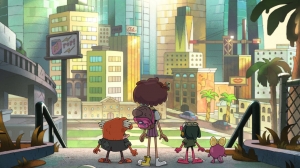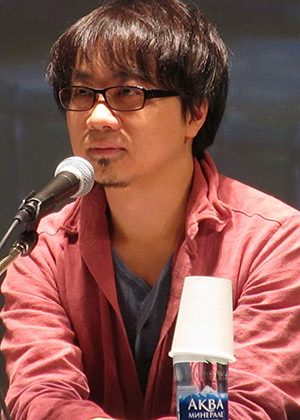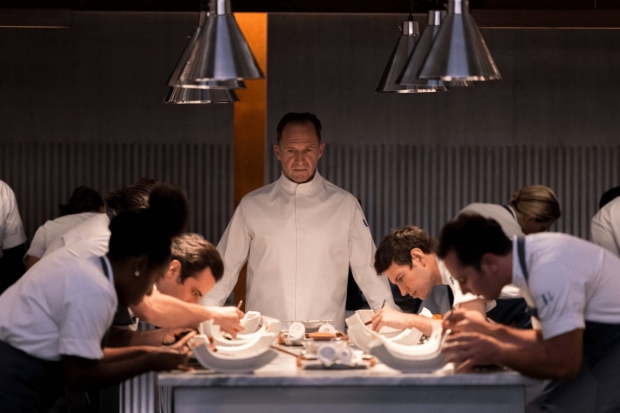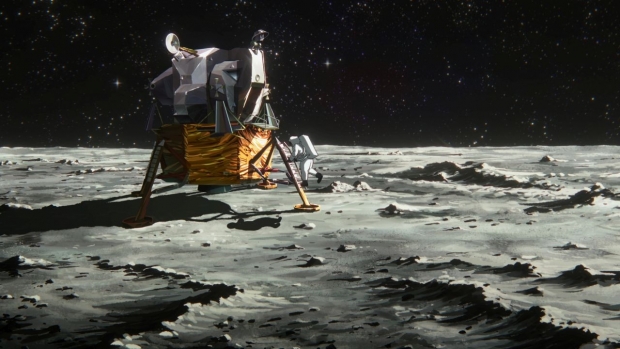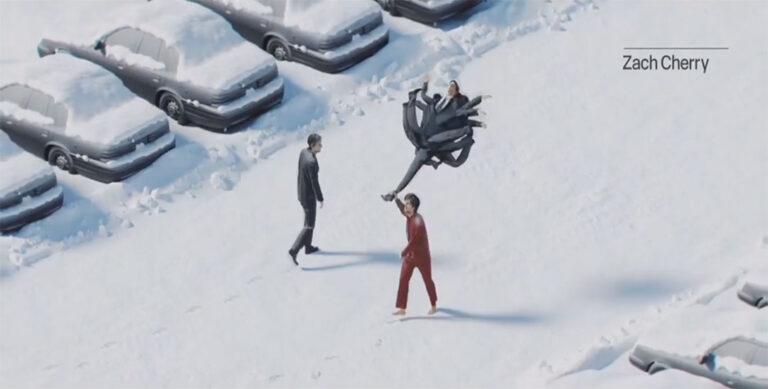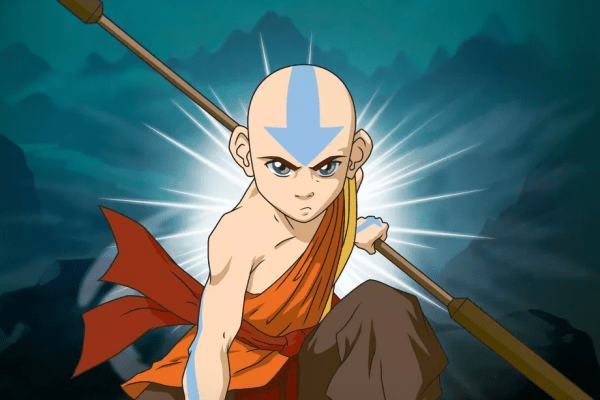Among those who know as well as anyone what Anne has gone through are the group of writers who have been with Braly since the beginning. Unusual for a writers’ room, more than half of the Amphibia team are women, many of them Asian. Braly is extremely gratified personally that everyone has stuck around, and points out that the writers’ loyalty and commitment has allowed for greater consistency in the characters and the storytelling.
“The show has always been Anne’s,” he emphasizes. “And for me, it’s really important in a story like this – this kind of hero’s journey – that the protagonist must confront their past. So, it was inevitable for me that she would eventually have to return to LA and reaffirm or investigate her relationship with her parents and the world that she came from. Because she’s a very different person now after two seasons in Amphibia and she’s been through a lot.”
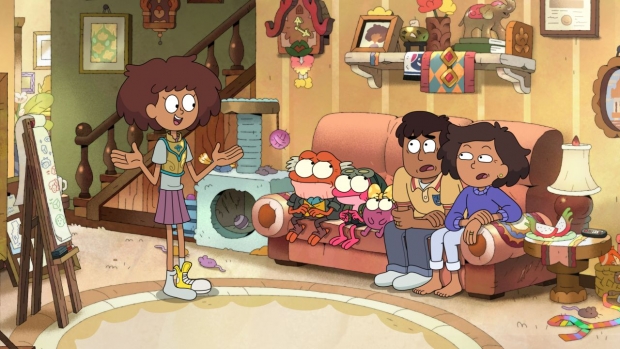
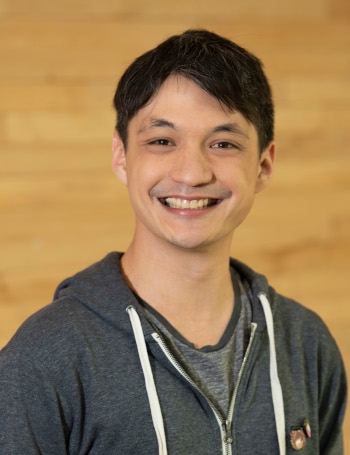
“Their being in Los Angeles meant that we had to do more R & D for this season than we did for Season 2,” Braly says. “What does our LA look like? What does it feel like? This is a new setting, which means that the art directors had to figure out exactly what that means for our show.”
In Amphibia’s third season, which debuts on Saturday, Oct. 2, at (9:30 a.m. EDT) on Disney Channel and DisneyNOW, the tables are turned as heroine Anne Boonchuy and her adoptive frog family, the Plantars, find themselves in Los Angeles, where the walking, talking frogs must conceal their identities as they search for a way home. That’s after making the acquaintance of Anne’s real family, who are, shall we say, nonplussed.
Asked to sum up what, in the final analysis, is the most distinctive thing about Amphibia, Braly comes back to the idea of flow.
—
And, unexpectedly, being forced to do things differently actually led Braly to an important realization.
“You need to give these gags space to breathe,” he concludes. “It’s very much like music, it demands a certain rhythm, a certain flow. And I think that, in 2021, we are so desperate for eyeballs that it can be very tempting to just assault the viewer with a lot of stuff and hope it will bring them in. But I’ve always believed that it’s great characters and good storytelling that will bring people to the table. And I think that ultimately that will have the best payoff for the audience.”
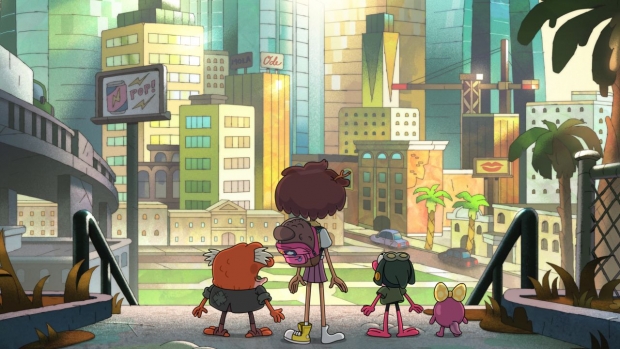
Dan Sarto is Publisher and Editor-in-Chief of Animation World Network.
Since it premiered on Disney Channel in June 2019, Matt Braly’s Amphibia, in which an ordinary girl finds herself transported to a world inhabited by frogs, has distinguished itself by its willingness to take its time. Sure, there are zany characters and plenty of funny gags, but the humor is always grounded in people’s behavior and the pacing allows the show to be more than just one crazy mishap after another.
“I think that tone has always been one of the most important things for us,” he says. “At the end of Season 2, things actually conclude in a very dramatic and kind of epic place for the characters. So, for the first episode of Season 3, it was really important for us to reset, in a way. The humor in this first episode had to be gentle enough that it didn’t feel disrespectful to the events of the Season 2 finale.”
Braly begins by affirming that, apart from working with only two Korean animation studios instead of three, as in previous seasons, the production pipeline for the script-driven, hand-drawn 2D show hasn’t changed. However, the fact that we’re not in Amphibia any more required some serious adjusting.
Amphibia stars popular actress and longtime Disney Channel star Brenda Song (Dollface) as Anne Boonchuy; Justin Felbinger (Disney Junior’s Miles From Tomorrowland) as Sprig Plantar, who forges a once-in-a-lifetime friendship with Anne; Amanda Leighton (This Is Us) as unpredictable pollywog (aka tadpole) Polly Plantar, the youngest member of the Plantar family; and Disney Legend Bill Farmer (the voice of Goofy) as overprotective and traditional grandfather Hop Pop. The show is a production of Disney Television Animation and carries a TV-Y7 parental guideline.
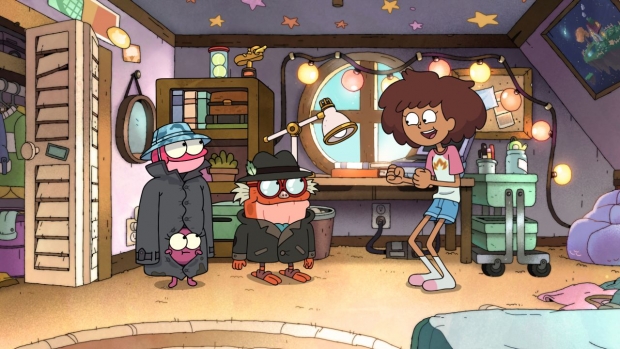
By way of example, he cites an episode in Season 3, where Anne and the frogs visit Wat Thai, a replica of a traditional Buddhist temple in Thailand. “[Writer] Gloria Shen, who took care of that story, really took a personal interest in it and wanted to make sure that the representation was good and felt right,” he recalls. “We’ve been in Amphibia this whole time, but now truly we are in LA, and we’re wanting to do this culture justice.”
Of course, like all shows produced during the past year, Amphibia had to contend with the limitations imposed by COVID. While Braly and his colleagues definitely felt the impact of restricted interaction, they found ways to compensate.
Braly goes on to explain that the decision to switch the location to Anne’s hometown, far from being arbitrary, was an organic part of Amphibia’s narrative trajectory.
“As the showrunner, one of the things I always did was pitch the storyboards to the network,” he shares. “But COVID sort of necessitated that we streamline our pipeline a little bit, so the board artists started doing the pitching for Season 3. And they were amazing. They were better than I ever could have been. And it really made me think that, for these past two years, they could have done it and would have done an amazing job. So it’s one of those great examples of how sometimes, by letting go, you get a better product.”

“The biggest thing that was missing was the kind of energy and chemistry you get from being in a big group of creatives, with 30 or 40 of us walking around, bumping into each other and sharing ideas,” Braly observes. “And so we did our best to get those kind of organic interactions back. Like in our storyboard pitches, when everyone has to mute themselves, people would draw funny things on the screen. It’s harder to get good chemistry going in Zoom, but the writers were so committed to the material that we still found a way to tell the best story possible.”
